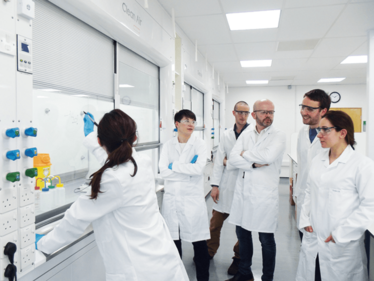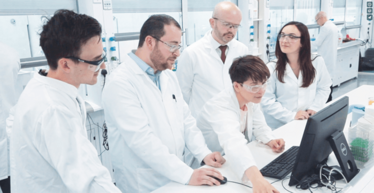The Medicinal Chemistry Puzzle: Lessons Learned with James Hitchin
From big pharma, to cancer research, to joining a fast-growing CRO, James Hitchin has gained multiple perspectives on a subject that has become his passion – medicinal chemistry. Here, he reflects on the changing landscape within the UK, its impact on his career path, and the pitfalls and perks of the field.
Always try to gain exposure to talent…
After completing a PhD in synthetic chemistry at the University of Liverpool in the UK, the first industry position I had was with Pfizer. I was promoted after a few months to lead six people in the synthetic services team, as well as running some synthesis myself. This position exposed me to a wide range of chemistries, different therapeutic areas, and a lot of talented people. After that, I experienced different roles and working practices in several companies. I initially moved up to Scotland to work for a Finnish company called Kemira Kemfine, where I was employed as team leader, running GMP manufacturing processes for a range of big pharmaceutical partners. I subsequently headed south to Dorset, where I worked as a chemistry leader for SAFC Pharma for three years, again working on the development and implementation of GMP manufacturing processes of APIs. It was a fascinating role because I was involved in everything from really small-scale medicinal chemistry work, all the way up to large-scale manufacturing processes that were conducted in their pilot plant facility. Some of these materials were also taken into human clinical trials at various stages. However, SAFC began consolidating their interests in the UK in 2009, which prompted me to move into a different kind of role – a senior scientist with Cancer Research UK (CRUK).
But don’t forget clinicians and patients!
At CRUK, I had the opportunity to work on a wide range of projects, from hit finding all the way through to lead optimization. One of the projects I worked on is currently going into preclinical development for the treatment of breast cancer, so this was a really interesting time in my career and very different to the commercial work that I had been involved with before. I was also able to contribute to a large number of publications.
The way in which the organization was set up meant that we were embedded within the Christie NHS Foundation Trust in Manchester, UK, which functions exclusively as a cancer hospital. At the time, CRUK had a strategy of creating drug discovery units (DDUs) which they embedded in specialist locations, giving us direct interaction with clinical researchers at the cutting edge of cancer research. They were generating novel discoveries, and we were getting pre-publication access to the information that they were finding – some of which was related to novel therapeutic targets. Part of my role involved being a key liaison for the cancer research community in Manchester, which meant that I got to do a lot of work with clinical researchers and interact directly with patients.
I have so many memorable moments from my work at CRUK. I remember one woman presenting with leukaemia. At that time, we were working on a program with a specific target: lysine-specific demethylase 1 (LSD1), which is linked to acute myeloid leukaemia (AML). We’d synthesized some small molecules within the unit, which we prepared as compounds against LSD1 for one of the clinical fellows in the hospital. He took a blood sample from this young lady, and confirmed that she had AML. He brought the sample back to his lab, took a solution of our compound, treated the sample with it, and cultured the cells. He was able to show that the compound was having an effect on the disease state, leading to differentiation of these leukaemia cells. This was the power of our position within that unit – you could make discoveries and potentially follow up on them immediately. Ultimately, the work led to a clinical trial.
Keep your eyes on the end result
One of the big philosophies of CRUK was the importance of target validation – being able to demonstrate categorically that if you modulate the activity of a particular protein, for example, that it is going to deliver a desirable therapeutic benefit. No matter what therapeutic area you are working in, it is important to remember the “line of sight to the clinic” – and that means being able to ask clinical researchers and doctors about the relevance of your work.
Having such expertise and insight to draw on helped massively with our task of identifying new targets and validating their role in cancer. We were then able to set up robust screening platforms to identify relevant small molecules, allowing us to thoroughly interrogate their pharmacology, and show in vitro and, ultimately, in an in vivo setting, that modulating the activity of a given target was going to deliver the desired benefit in a patient. Coupled with the expertise of our biochemistry and cellular pharmacology colleagues in the DDU, this work provided a solid platform for full target validation.


Know when to move on
“Moving on” has been a theme throughout my career. I stayed at CRUK for a long time until eventually, I felt that I’d gone as far as I could. My goal was to learn about the drug discovery process in an oncology setting, and to play a small role in delivering molecules that would have an impact on oncology patients – and I feel that I had achieved that. So, what was next? I needed an opportunity for change, and for personal growth.
That opportunity came at Charnwood Molecular, a UK-based contract research organization (CRO) with research sites in Loughborough and BioCity, Nottingham. Joining the company as Head of Medicinal Chemistry and Site Director at their BioCity labs gave me the opportunity to drive the expansion of their medicinal chemistry services, which sit alongside their synthetic and process research chemistry offerings (predominantly carried out in Loughborough). Speaking with the senior management team and owners at interview, I could see that they were heavily invested in the idea of building a world-class offering, and would be supportive of continuing to build a highly skilled team. Although I’d only ever looked after relatively small teams before, we are now close to employing 50 scientists across the company, up from just around 30 when I joined Charnwood at the end of 2016. The number of scientists at BioCity has almost tripled! In fact, our company has more than doubled its turnover in the last three years, and we have recently won a regional award for Export Achievement. In short, we delivered on our shared vision of an aggressive expansion – and it continues apace!
We now have many projects in medicinal chemistry, and we’re continuing with our traditional strengths in synthetic chemistry projects too. So, although I loved my time with CRUK, it couldn’t give me the opportunity I have now.
Outsourcing is growing, but people want to be close to home
Being at Charnwood as it grows so quickly is exciting, but you do have to consider how to grow sustainably when the industry is changing so much. I did an industrial year for Roche in 1999 in Welwyn Garden City; however, that site is no longer occupied by Roche – a similar and unfortunate development to that occurring at several other big organizations and sites that I used to work for. Some of these organizations have closed down their main research and development facilities in the UK, opting instead to outsource large amounts of their chemistry to CROs, like ours, allowing greater flexibility and cost savings. This has changed drug discovery considerably; however, as the cost differential between different countries narrows and therapeutic companies focus more on the added value propositions of their outsourcing partnerships, we’re seeing a lot of work that was traditionally done in the Far East coming back to the UK.
Many people were initially worried when larger companies began contracting out work and pulling out of the UK as a research location – there was a real fear that it would result in a skills gap, but contract research organizations, biotechs and academic groups are keeping skilled people in the UK, and supporting the skills required for drug discovery for the next generation of scientists coming through.
Stay on target
To succeed as a medicinal chemist, you have to be interested in solving complex, multi-parameter puzzles. Medicinal chemistry is the practice of designing small molecules – in principle to ask specific pharmacological questions about specific biological targets. If you can create a measurable effect, you gain a better understanding of your target and how it impacts the body. Next, you can work to design and optimize your compounds further. It’s almost like Lego on a molecular scale, but you have a strict set of parameters that you need to work within to eventually deliver compounds that will have the intended effect in a clinical setting (line of sight to the clinic!), whilst also avoiding unwanted side effects.
One obvious prerequisite for a successful molecule is potency against the target. In our projects, clients often come in with high-throughput screening data and have a few initial hit series that they’d like us to develop further. It’s all about prioritizing these hit series and understanding their potential limitations. This initial investigation can be used to prioritize hits that don’t contain any concerning structural features. At this stage, it’s also important to have a good understanding of the exact property profile that you’re looking for – generally referred to as a target product profile. You need to understand what you want in a hit or a lead compound, and understand the potential complexities and pitfalls you could face – it’s crucial to make good choices at the beginning of the process and pick a candidate that has the potential to go all the way.
Obviously, this is a multiparameter optimization process – your molecule has to have the right properties, but also unique structural characteristics that provide strong intellectual property position for eventual patenting purposes. Potential liabilities include poor solubility or poor permeability. Lipophilicity is also important to consider – if your compound is too lipophilic it can lead to high levels of metabolism, poor solubility and off-target effects. You have to really understand your compound and be able to juggle all of these parameters in a way that allows you to produce something that is well tolerated by the body, is rapidly absorbed, and goes directly to where you want it to be – and then stays there long enough to elicit the desired effect. Certainly, it’s a complex and challenging task, but it’s important to remember that there is a wealth of information to be found in the literature. You can learn a lot from compounds that have been made previously; why not benefit from the hard work and hard-fought victories of yesteryear?
Scaling up isn’t simple
Many projects that I’ve worked on in the past have come from big pharma companies, and it is often the case that you are handed a medicinal chemistry-scale route that is not suitable for large-scale manufacture – usually because of time constraints and market pressures. I have fond memories of one client who said, “We’ve only ever made several 300 mg batches of this material, but we now need 20 kg – here is the eight-stage linear route that we used. We need the material in three months.” Unfortunately, because of the different requirements and pressure of the two disciplines, you often receive a route and immediately realize that it is based on processes or materials that you simply can’t use on a larger scale. Scale up is a completely different mentality to the early stages of drug discovery! A former colleague of mine once said, “There are two yields in medicinal chemistry: no yield, or some yield.” But in process chemistry, you should be getting as close to 100 percent yield as possible with the cleanest possible profile. For every single impurity that appears in that reaction, you need to know why it’s there, how it’s formed, and develop a really intimate understanding of the process so you can control it, and understand entirely how different parameters will impact on the outcome of the reaction.
However, synthesis is usually a means to an end for a medicinal chemist – they just want the molecules needed to interrogate their targets. Asking a medicinal chemist to focus on scaling up can take away from their core activities. Another mistake I often see is too much focus on the synthetic tractability of a compound series – if you have five similar hits from a screen, people may choose the one that looks easy to make. In my view, that is always a bad decision – if you’re basing your choice entirely on synthetic tractability, you are missing a trick! Some of the best compounds can be the most difficult to synthesize. Perhaps counterintuitively, if you spend a bit more time figuring out the challenges in synthesis, you could ultimately end up with something more interesting not only in terms of its medicinal chemistry properties, but also more amenable to process-scale chemistry because you took the time to understand it in the first place.
Failure should be shared
In my experience, one of the most common pitfalls in medicinal chemistry is poor target validation. You have to be absolutely sure that modulation of the target will deliver the desired therapeutic benefit (preferably before you’ve invested millions of pounds!). It still surprises me how often you see weak target validation in terms of the link between their target and a disease, and how far they’ve gone to convince themselves that their target is important. I’ve seen a few projects come unstuck this way. Often, it isn’t reported as it’s seen as a source of embarrassment, but it’s probably costing the industry a great deal of money, especially as other companies will repeat the same mistakes.
Investments are being poured into new technologies, such as CRISPR gene editing and artificial intelligence. Many groups are now using these techniques in conjunction with existing target validation platforms to identify new targets, and improve our understanding of disease-related pharmacological processes. It is well documented that the reproducibility of novel landmark studies in leading peer-reviewed papers (the results of which are used across the industry as a source of new targets) can be as low as 20 to 25 percent.. During my time at CRUK, it was always stressed that although you may see something in the literature suggesting a particular target is interesting, you must always repeat the experiment, and then expand upon it, using different cell lines, tissue types, and so on. This is also why small molecules are so important: if you use gene editing to remove a protein from the system, you may see an effect that is different to what might happen if you modulate the activity of the target with a small molecule instead, indicating, for example, that the protein may be involved in an important protein-protein interaction.

Knowledge is out there – computers can help us find it
Looking forward, many new tools are being developed to help with molecule design. We are beginning to see machine learning and artificial intelligence applied to reaction optimization and route selection, and it appears to be effective, in some cases, for delivering efficient processes and designing molecules based on X-ray crystallographic information, for example. I predict an increasing role for computational approaches in the future as they should be able to reduce the amount of time we spend working out certain problems. In some respects, this will help to eliminate human error and allow us to look at large data sets much more objectively and effectively, and use them to direct design. There’s a whole wealth of information to be found in the literature, and any systems or platforms that will allow us to consolidate and interrogate that in a way that improves drug discovery can only be a good thing. However, there’s still a lot to be said for human experience! I think the real benefit of computational approaches is helping people access the information they need to ask the right questions of their target in a structured and rapid way.
The ultimate objective is to find a compound that makes it all the way to market to have a positive effect for patients. I can only hope that by the end of my career, I have been able to be part of delivering several drugs that impact patients, allowing people to live richer and fuller lives – that would be a wonderful thing to achieve.
James Hitchin is Head of Medicinal Chemistry at Charnwood Molecular, UK.
James Hitchin is Head of Medicinal Chemistry at Charnwood Molecular, UK.



















